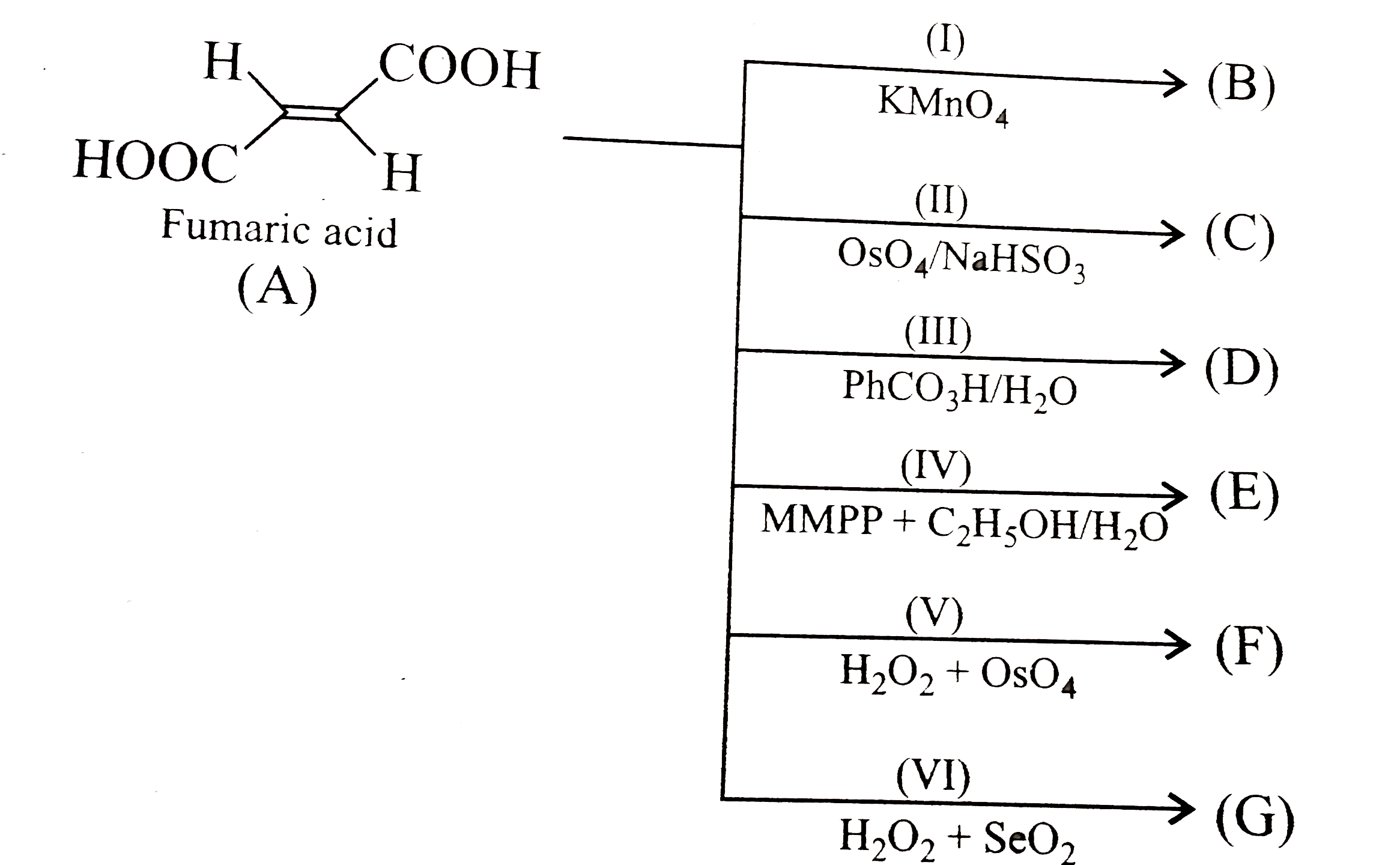Treatment of tartaric acid with Fenton's reagent gives :
Pyruvic acid
Maleic acid
Tartaric anhydride
Dihydroxyfurmaric acid
The correct Answer is:C
To solve the question regarding the treatment of tartaric acid with Fenton's reagent, we can follow these steps:
Step 1: Understand the Reactants
- Tartaric Acid: Tartaric acid is a naturally occurring organic acid with the formula C4H6O6. It contains two carboxylic acid groups (-COOH) and two hydroxyl groups (-OH).
- Fenton's Reagent: Fenton's reagent consists of ferrous iron (Fe²⁺) and hydrogen peroxide (H₂O₂). It is known for its ability to oxidize organic compounds.
Step 2: Analyze the Reaction
- When tartaric acid is treated with Fenton's reagent, the ferrous ion (Fe²⁺) and hydrogen peroxide (H₂O₂) will facilitate the oxidation of tartaric acid.
- The reaction involves the removal of hydrogen atoms, leading to the formation of double bonds in the structure of tartaric acid.
Step 3: Identify the Product
- The oxidation process will convert tartaric acid into a compound that has double bonds due to the removal of hydrogen atoms.
- The resulting compound will have two hydroxyl groups and a double bond, which corresponds to the structure of dihydroxyfumaric acid.
Step 4: Conclusion
- The final product formed from the reaction of tartaric acid with Fenton's reagent is dihydroxyfumaric acid.
Final Answer
The treatment of tartaric acid with Fenton's reagent gives dihydroxyfumaric acid.
---
- Tartaric Acid: Tartaric acid is a naturally occurring organic acid with the formula C4H6O6. It contains two carboxylic acid groups (-COOH) and two hydroxyl groups (-OH).
- Fenton's Reagent: Fenton's reagent consists of ferrous iron (Fe²⁺) and hydrogen peroxide (H₂O₂). It is known for its ability to oxidize organic compounds.
- When tartaric acid is treated with Fenton's reagent, the ferrous ion (Fe²⁺) and hydrogen peroxide (H₂O₂) will facilitate the oxidation of tartaric acid.
- The reaction involves the removal of hydrogen atoms, leading to the formation of double bonds in the structure of tartaric acid.
- The oxidation process will convert tartaric acid into a compound that has double bonds due to the removal of hydrogen atoms.
- The resulting compound will have two hydroxyl groups and a double bond, which corresponds to the structure of dihydroxyfumaric acid.
- The final product formed from the reaction of tartaric acid with Fenton's reagent is dihydroxyfumaric acid.
The treatment of tartaric acid with Fenton's reagent gives dihydroxyfumaric acid.
Topper's Solved these Questions
- CARBOXYLIC ACIDS AND THEIR DERIVATIVESBook:CENGAGE CHEMISTRY ENGLISHChapter:CARBOXYLIC ACIDS AND THEIR DERIVATIVESExercise:Exercises (Assertion-Reasoning)
Explore 10 Videos
- CARBOXYLIC ACIDS AND THEIR DERIVATIVESBook:CENGAGE CHEMISTRY ENGLISHChapter:CARBOXYLIC ACIDS AND THEIR DERIVATIVESExercise:Exercises Archives (Single Correct)
Explore 10 Videos
- CARBOXYLIC ACIDS AND THEIR DERIVATIVESBook:CENGAGE CHEMISTRY ENGLISHChapter:CARBOXYLIC ACIDS AND THEIR DERIVATIVESExercise:Exercises (Multiple Correct)
Explore 34 Videos
- BIOMOLECULESBook:CENGAGE CHEMISTRY ENGLISHChapter:BIOMOLECULESExercise:Exercises Archives (Analytical And Descriptive)
Explore 8 Videos
- CHEMICAL KINETICSBook:CENGAGE CHEMISTRY ENGLISHChapter:CHEMICAL KINETICSExercise:Archives Subjective
Explore 23 Videos
Similar Questions
Knowledge Check
Following stereo-structure of tartaric acid represents :
 Ad or l formBracemic formCmeso formDNone of these
Ad or l formBracemic formCmeso formDNone of these
Lactic acid on oxidation with Fenton's reagent gives:
View SolutionGlycerol on oxidation with Fenton's reagent gives a mixture of………………..and………………….
View SolutionWhen lactic acid is subjected to oxidation with Fenton's reagent, the main product formed is :
View Solution
Meso-tartaric acid is formed in :
View SolutionTreatment of benzoic acid with Cl2/FeCl3 will give
View SolutionTreatment of propionadehyde with dilute NaOH gives :
View SolutionTreatment of propionadehyde with dilute NaOH gives :
View Solution